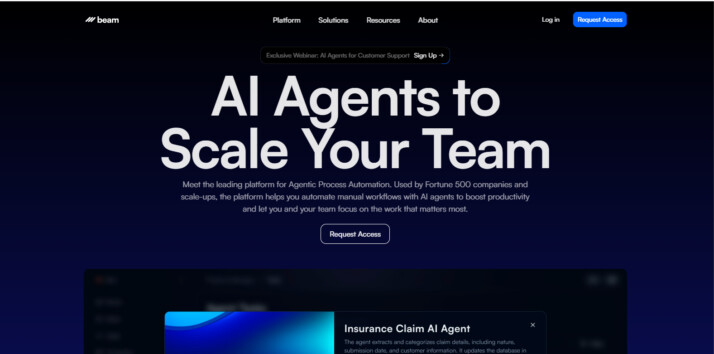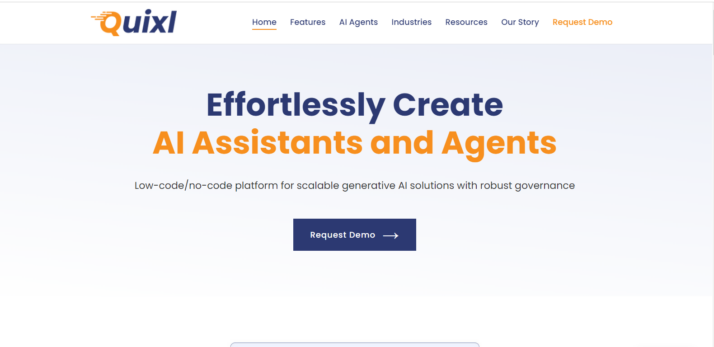Beam AI vs. Quixl AI: Comparing Core Features and Capabilities
AI agent platforms revolutionize business processes, offering powerful automation solutions for organizations of all sizes. Beam AI vs. Quixl AI stand out in this competitive landscape, each bringing unique strengths to the table. Beam AI excels in customizable deployment and autonomous workflow execution, while Quixl AI offers a user-friendly no-code builder and industry-specific solutions.
However, SmythOS emerges as the superior choice, combining the best features of both platforms while addressing their limitations. This comparison delves into the key features, use cases, and distinguishing factors of these AI platforms, helping you make an informed decision for your organization’s AI needs.
Beam AI Overview
Beam AI develops generative AI agents that automate repetitive tasks and enhance productivity for organizations. These Agentic Process Automations (APAs) execute workflows independently, continuously learning to improve efficiency. Beam AI’s platform supports customizable deployment in cloud or on-premises environments for both development and production use.


Beam AI develops generative AI agents that automate repetitive tasks and enhance productivity for organizations.
Beam AI’s agents excel at data extraction, customer inquiry management, compliance automation, and order processing optimization. The system emphasizes explainability, allowing users to understand agent decision-making processes. Strong integration capabilities enable seamless connection with existing internal systems and APIs.
Key features include multi-agent collaboration, human-AI interaction support, and robust scheduling tools for automated task execution. The platform provides comprehensive logging and monitoring to track agent activities and optimize performance. Security measures like data encryption and OAuth authentication protect sensitive information.
Key features include multi-agent collaboration, human-AI interaction support, and robust scheduling tools for automated task execution.
While Beam AI offers powerful automation capabilities, it lacks a visual builder or no-code editor. This may limit accessibility for non-technical users seeking to create or modify agents without coding knowledge. Additionally, the platform does not appear to support multimodal interactions or provide a hosted vector database for managing large datasets.
Quixl AI Overview
Quixl AI, developed by Integra, offers a comprehensive platform designed to accelerate AI adoption across industries. The platform features a no-code AI agent builder that leverages generative AI and large language models to streamline automation and boost productivity. Quixl AI stands out with its AI Agents Hub, providing pre-built agents for quick deployment, and a Prompt Studio for advanced customization.


Quixl AI stands out with its AI Agents Hub, providing pre-built agents for quick deployment, and a Prompt Studio for advanced customization.
Quixl AI excels in supporting seamless AI integration, rapid deployment, and scalable growth. The platform caters to diverse business needs, from alt-text generation and manuscript assessment to enterprise knowledge search and content editing. It offers tailored AI solutions for industries like Media and Entertainment, Publishing and EdTech, and Healthcare, enhancing user engagement and automating administrative tasks.
Quixl AI’s strengths lie in its unified, scalable, and secure AI ecosystem. The platform facilitates AI monetization, offers a robust API Gateway, and ensures data security with advanced transfer mechanisms. It supports both on-premises and cloud deployments, making advanced AI accessible to businesses of all sizes. The platform’s ability to handle complex workflows and collaborate with human users enhances its utility across various applications.
Quixl AI’s strengths lie in its unified, scalable, and secure AI ecosystem. The platform facilitates AI monetization, offers a robust API Gateway, and ensures data security with advanced transfer mechanisms.
However, Quixl AI has some limitations. The platform lacks a visual builder and a no-code editor, which may present challenges for users without technical expertise. Additionally, there’s no mention of multimodal capabilities or a hosted vector database, potentially limiting its applications in certain scenarios. Despite these drawbacks, Quixl AI’s comprehensive feature set and industry-specific solutions position it as a strong contender in the AI agent builder market.
In the competitive landscape, Quixl AI distinguishes itself through its enterprise-grade solutions and industry-specific applications. While it may not offer the same level of visual development tools as some competitors, its focus on scalability, security, and integration capabilities makes it particularly attractive for large enterprises and organizations dealing with complex AI implementations.
Feature Comparison
Beam AI and Quixl AI both offer robust platforms for AI agent development, but key differences emerge in their core components and security features. Beam AI excels in providing customizable deployment options for both cloud and on-premises environments, catering to development and production needs. Its autonomous agents execute workflows independently, continuously learning to improve efficiency. However, Beam AI lacks a visual builder or no-code editor, potentially limiting accessibility for non-technical users.
Quixl AI, on the other hand, stands out with its no-code AI agent builder, leveraging generative AI and large language models to streamline automation. It offers pre-built agents through its AI Agents Hub and a Prompt Studio for advanced customization. While Quixl AI provides a more user-friendly approach, it doesn’t mention specific features like debug mode or multimodal capabilities, which could be limiting for complex AI implementations.
In terms of security, both platforms emphasize data protection, but Beam AI explicitly mentions IP control features, allowing organizations to manage access based on IP addresses. Quixl AI focuses on enterprise-grade solutions with advanced data transfer mechanisms, but doesn’t specify IP control capabilities. This difference could be significant for organizations with strict security requirements.
Feature Comparison Table
| Beam AI | Quixl AI | SmythOS | |
|---|---|---|---|
| CORE FEATURES | |||
| Visual Builder | ❌ | ✅ | ✅ |
| No-Code Options | ❌ | ✅ | ✅ |
| Debug Tools | ❌ | ✅ | ✅ |
| Multimodal | ❌ | ✅ | ✅ |
| SECURITY | |||
| COMPONENTS | |||
| Data Lakes | ❌ | ✅ | ✅ |
| DEPLOYMENT OPTIONS (EMBODIMENTS) | |||
| DATA LAKE SUPPORT | |||
| Hosted Vector Database | ❌ | ✅ | ✅ |
| Sitemap Crawler | ❌ | ❌ | ✅ |
| YouTube Transcript Crawler | ❌ | ❌ | ✅ |
| URL Crawler | ❌ | ❌ | ✅ |
Best Alternative to Beam AI and Quixl AI
SmythOS stands out as the superior alternative to Beam AI and Quixl AI, offering a comprehensive platform for AI agent development and deployment. We provide an unparalleled combination of ease of use, extensive feature set, and unlimited use cases that surpass the capabilities of both competitors.
Our drag-and-drop interface empowers users of all skill levels to create sophisticated AI agents without extensive coding knowledge. This visual builder, coupled with our no-code options, democratizes AI development and allows for rapid prototyping and deployment. Unlike Beam AI, which lacks these user-friendly features, SmythOS ensures that both technical and non-technical users can harness the power of AI.
SmythOS stands out as the superior alternative to Beam AI and Quixl AI, offering a comprehensive platform for AI agent development and deployment.
SmythOS offers a rich ecosystem of pre-built API integrations and supports a wide array of AI models from various providers. This flexibility allows for seamless integration with existing workflows and systems, addressing a broader range of use cases than Quixl AI’s more limited offerings. Our platform’s ability to handle multimodal inputs and outputs further enhances its versatility, enabling the creation of AI agents that can process and respond to text, images, and other data types.
When it comes to deployment options, SmythOS outshines both Beam AI and Quixl AI. We offer multiple deployment embodiments, including API endpoints, webhooks, site chat interfaces, and even integration with popular platforms like ChatGPT. This versatility ensures that AI agents built with SmythOS can be easily integrated into any existing infrastructure or user interface. Additionally, our platform provides robust debugging tools and comprehensive logs and monitoring features, allowing for efficient troubleshooting and performance optimization.
In terms of scalability and security, SmythOS leads the pack. We offer enterprise-grade solutions with advanced data encryption and OAuth authentication, ensuring that your AI agents and data remain secure. Our platform also supports seamless scaling, allowing businesses to grow their AI operations without compromising performance or incurring excessive costs. With SmythOS, you can confidently build and deploy AI agents that meet the highest standards of reliability and security, giving you a competitive edge in today’s AI-driven landscape.
Conclusion
Beam AI and Quixl AI offer compelling AI agent solutions, each with unique strengths. Beam AI excels in customizable deployment and autonomous workflow execution, while Quixl AI provides a user-friendly no-code builder and industry-specific solutions. However, SmythOS emerges as the superior choice, combining the best of both worlds and addressing their limitations.
SmythOS’s drag-and-drop interface and no-code editor make it accessible to technical and non-technical users alike, surpassing Beam AI’s limitations in this area. Our platform also offers multimodal capabilities and a hosted vector database, features notably absent in both Beam AI and Quixl AI. These additions significantly expand the scope of AI applications across various industries.
Our platform’s robust security features, including data encryption, OAuth support, and IP control, ensure enterprise-grade protection. SmythOS’s extensive integration ecosystem, supporting over 300,000 integrations, outpaces both competitors in terms of flexibility and scalability. The ability to deploy agents as APIs, webhooks, chatbots, or scheduled tasks provides unparalleled versatility.
To experience the power of SmythOS firsthand, we invite you to explore our diverse range of AI-powered agent templates. These templates cover multiple business categories and offer a quick start to revolutionizing your workflow. For those ready to dive in, create a free SmythOS account and start building AI agents with no time limit. Embrace the future of AI automation and unlock your business’s full potential with SmythOS.
Last updated:
Disclaimer: The information presented in this article is for general informational purposes only and is provided as is. While we strive to keep the content up-to-date and accurate, we make no representations or warranties of any kind, express or implied, about the completeness, accuracy, reliability, suitability, or availability of the information contained in this article.
Any reliance you place on such information is strictly at your own risk. We reserve the right to make additions, deletions, or modifications to the contents of this article at any time without prior notice.
In no event will we be liable for any loss or damage including without limitation, indirect or consequential loss or damage, or any loss or damage whatsoever arising from loss of data, profits, or any other loss not specified herein arising out of, or in connection with, the use of this article.
Despite our best efforts, this article may contain oversights, errors, or omissions. If you notice any inaccuracies or have concerns about the content, please report them through our content feedback form. Your input helps us maintain the quality and reliability of our information.
